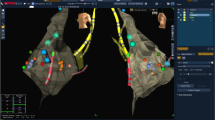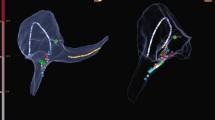Abstract
Background
Little is known about the long-term outcomes of catheter ablation of supraventricular tachycardia (SVT) using remote magnetic navigation system (RMN).
Methods
One hundred twenty patients underwent catheter ablation of SVTs with RMN (Niobe, Stereotaxis, USA): atrioventricular nodal re-entrant tachycardia (AVNRT; n = 59), atrioventricular re-entrant tachycardia (AVRT; n = 45), and focal atrial tachycardia (AT, n = 16). The outcome of AVRT with right free wall accessory pathway was compared with those of a group of 26 consecutive patients undergoing manual ablation.
Results
Mean follow-up period was 2.2 ± 1.4 years. Overall arrhythmia-free survival was 86 %; AVRT (77 %), AVNRT (96 %), and focal AT (71 %). After the learning period (initial 50 cases), procedural outcomes had improved for AVRT and AVNRT (91 % in overall group, 90 % in AVRT group, 100 % in AVNRT group, and 68 % in focal AT group). The recurrence-free rate was higher for the free wall accessory pathways than those of the other sites (92 vs. 73 %, log-rank P = 0.06). Furthermore, when it is confined for the right free wall accessory pathway, RMN showed excellent long-term outcome (7/7, 100 %) compared to the results of manual approach (18/26, 69.2 %, log-rank P = 0.07).
Conclusions
RMN showed favorable long-term outcomes for the ablation of SVT. In our experience, RMN-guided ablation may be associated with a higher success rate as compared to manual ablation when treating right-sided free wall pathways.



Similar content being viewed by others
References
Jackman, W. M., Wang, X. Z., Friday, K. J., Roman, C. A., Moulton, K. P., Beckman, K. J., et al. (1991). Catheter ablation of accessory atrioventricular pathways (Wolff-Parkinson-White syndrome) by radiofrequency current. New England Journal of Medicine, 324(23), 1605–1611.
Calkins, H., Sousa, J., el-Atassi, R., Rosenheck, S., de Buitleir, M., Kou, W. H., et al. (1991). Diagnosis and cure of the Wolff-Parkinson-White syndrome or paroxysmal supraventricular tachycardias during a single electrophysiologic test. New England Journal of Medicine, 324(23), 1612–1618.
Kuck, K. H., Schlüter, M., Geiger, M., Siebels, J., & Duckeck, W. (1991). Radiofrequency current catheter ablation of accessory atrioventricular pathways. Lancet, 337(8757), 1557–1561.
Jackman, W. M., Beckman, K. J., McClelland, J. H., Wang, X., Friday, K. J., Roman, C. A., et al. (1992). Treatment of supraventricular tachycardia due to atrioventricular nodal reentry, by radiofrequency catheter ablation of slow-pathway conduction. New England Journal of Medicine, 327(5), 313–318.
Haissaguerre, M., Gaita, F., Fischer, B., Commenges, D., Montserrat, P., d’Ivernois, C., et al. (1992). Elimination of atrioventricular nodal reentrant tachycardia using discrete slow potentials to guide application of radiofrequency energy. Circulation, 85(6), 2162–2175.
Faddis, M. N., Blume, W., Finney, J., Hall, A., Rauch, J., Sell, J., et al. (2002). Novel, magnetically guided catheter for endocardial mapping and radiofrequency catheter ablation. Circulation, 106(23), 2980–2985.
Faddis, M. N., Chen, J., Osborn, J., Talcott, M., Cain, M. E., & Lindsay, B. D. (2003). Magnetic guidance system for cardiac electrophysiology: a prospective trial of safety and efficacy in humans. Journal of the American College of Cardiology, 42(11), 1952–1958.
Al-Ahmad, A., Grossman, J. D., & Wang, P. J. (2005). Early experience with a computerized robotically controlled catheter system. Journal of Interventional Cardiac Electrophysiology, 12(3), 199–202.
Xu, D., Yang, B., Shan, Q., Zou, J., Chen, M., Chen, C., et al. (2009). Initial clinical experience of remote magnetic navigation system for catheter mapping and ablation of supraventricular tachycardias. Journal of Interventional Cardiac Electrophysiology, 25(3), 171–174.
Bauernfeind, T., Akca, F., Schwagten, B., de Groot, N., Van Belle, Y., Valk, S., et al. (2011). The magnetic navigation system allows safety and high efficacy for ablation of arrhythmias. Europace: European Pacing, Arrhythmias, and Cardiac Electrophysiology, 13(7), 1015–1021.
Calkins, H., Yong, P., Miller, J. M., Olshansky, B., Carlson, M., Saul, J. P., et al. (1999). Catheter ablation of accessory pathways, atrioventricular nodal reentrant tachycardia, and the atrioventricular junction: final results of a prospective, multicenter clinical trial. The Atakr Multicenter Investigators Group. Circulation, 99(2), 262–270.
Belhassen, B., Rogowski, O., Glick, A., Viskin, S., Ilan, M., Rosso, R., et al. (2007). Radiofrequency ablation of accessory pathways: a 14 year experience at the Tel Aviv Medical Center in 508 patients. Israel Medical Association Journal, 9(4), 265–270.
Chen, M. L., Yang, B., Ju, W. Z., Chen, H. W., Chen, C., Hou, X. F., et al. (2010). Right-sided free wall accessory pathway refractory to conventional catheter ablation: lessons from 3-dimensional electroanatomic mapping. Journal of Cardiovascular Electrophysiology, 21(12), 1317–1324.
Becker, A. E., Anderson, R. H., Durrer, D., & Wellens, H. J. (1978). The anatomical substrates of Wolff-Parkinson-White syndrome. A clinicopathologic correlation in seven patients. Circulation, 57(5), 870–879.
Becker, A. E., & Anderson, R. H. (1981). The Wolff-Parkinson-White syndrome and its anatomical substrates. Anatomical Record, 201(1), 169–177.
Anderson, R. H., & Ho, S. Y. (1997). Anatomy of the atrioventricular junctions with regard to ventricular preexcitation. Pacing and Clinical Electrophysiology, 20(8 Pt 2), 2072–2076.
Ernst, S., Ouyang, F., Linder, C., Hertting, K., Stahl, F., Chun, J., et al. (2004). Initial experience with remote catheter ablation using a novel magnetic navigation system: magnetic remote catheter ablation. Circulation, 109(12), 1472–1475.
Wood, M. A., Orlov, M., Ramaswamy, K., Haffajee, C., & Ellenbogen, K. (2008). Remote magnetic versus manual catheter navigation for ablation of supraventricular tachycardias: a randomized, multicenter trial. Pacing and Clinical Electrophysiology, 31(10), 1313–1321.
Thornton, A. S., Janse, P., Theuns, D. A., Scholten, M. F., & Jordaens, L. J. (2006). Magnetic navigation in AV nodal re-entrant tachycardia study: early results of ablation with one- and three-magnet catheters. Europace: European Pacing, Arrhythmias, and Cardiac Electrophysiology, 8(4), 225–230.
Davis, D. R., Tang, A. S., Gollob, M. H., Lemery, R., Green, M. S., & Birnie, D. H. (2008). Remote magnetic navigation-assisted catheter ablation enhances catheter stability and ablation success with lower catheter temperatures. Pacing and Clinical Electrophysiology, 31(7), 893–898.
Latcu, D. G., Ricard, P., Zarqane, N., Yaici, K., Rinaldi, J. P., Maluski, A., et al. (2009). Robotic magnetic navigation for ablation of human arrhythmias: initial experience. Archives of Cardiovascular Diseases, 102(5), 419–425.
Ernst, S., Ouyang, F., Linder, C., Hertting, K., Stahl, F., Chun, J., et al. (2004). Modulation of the slow pathway in the presence of a persistent left superior caval vein using the novel magnetic navigation system Niobe. Europace: European Pacing, Arrhythmias, and Cardiac Electrophysiology, 6(1), 10–14.
Acknowledgments
We thank Jeong-Wook Park, Young-Woong Ha, and Bo-Kyung Kim for providing sincere assistance in clinical and electrocardiographic data acquisition and measurement.
Conflict of interest
None.
Author information
Authors and Affiliations
Corresponding author
Rights and permissions
About this article
Cite this article
Kim, SH., Oh, YS., Kim, DH. et al. Long-term outcomes of remote magnetic navigation for ablation of supraventricular tachycardias. J Interv Card Electrophysiol 43, 187–192 (2015). https://doi.org/10.1007/s10840-015-9991-6
Received:
Accepted:
Published:
Issue Date:
DOI: https://doi.org/10.1007/s10840-015-9991-6




